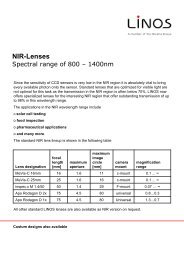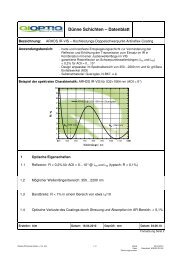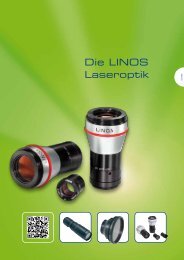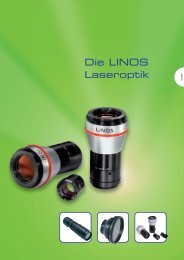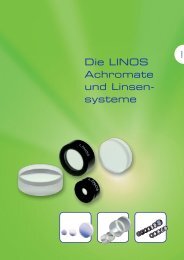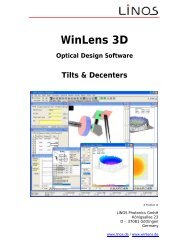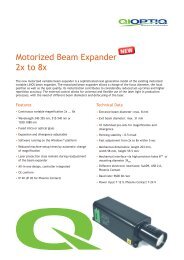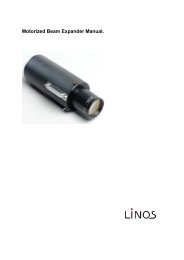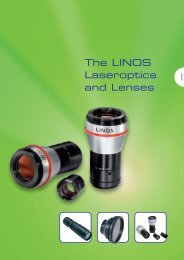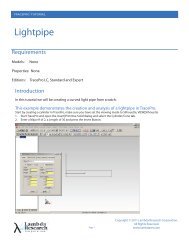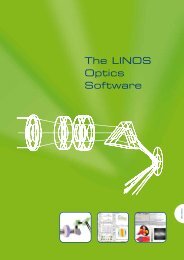08-Optical Tables.pdf - Qioptiq Q-Shop
08-Optical Tables.pdf - Qioptiq Q-Shop
08-Optical Tables.pdf - Qioptiq Q-Shop
You also want an ePaper? Increase the reach of your titles
YUMPU automatically turns print PDFs into web optimized ePapers that Google loves.
<strong>Optical</strong> <strong>Tables</strong><br />
Vibration-Isolation Systems<br />
The choice of supports and vibrationisolation<br />
systems will have a significant<br />
affect on the performance of <strong>Optical</strong><br />
Table systems.<br />
The purpose of vibration-isolation<br />
systems is isolating, to the maximum<br />
extent feasible, Table Tops from vibrations<br />
emanating from, or transmitted by,<br />
the floors or other surfaces on which<br />
their supports stand. The fre quen cies of<br />
these vibrations usually range from<br />
about 2 Hz up to 50 Hz, depending upon<br />
the characteristics and location of the<br />
floors, or other supporting surfaces,<br />
involved, as well as upon ambient<br />
conditions.<br />
Practice indicates that spring-mass<br />
mechanisms are the best choices for such<br />
Transmissibility<br />
applications, but they must be tuned<br />
such that their natural resonant frequencies<br />
fall well below the frequencies of<br />
lowest-order building resonances if they<br />
are to provide high degrees of vibrational<br />
isolation.<br />
The vibrational-transfer characteristics,<br />
or transmissi bili ties, of undamped<br />
spring-mass mechanisms are roughly as<br />
indicated in the graphs shown below,<br />
where ω 0<br />
is their natural resonant<br />
frequency.<br />
In addition to providing isolation from<br />
building vibra tions, vibration-isolation<br />
systems should strongly isolate experimental<br />
setups from incidental vibrations<br />
due to, e.g., persons walking about, etc.,<br />
and should strongly dampen these<br />
Transmissibility<br />
occurences; i.e., they should rapidly<br />
damp vibrations at all frequencies likely<br />
to be encoun tered in actual use. This<br />
may be implemented by incor porating<br />
various types of damping mechanisms,<br />
such as eddy-current damping or<br />
frictional/viscous damping using solid,<br />
liquid, or gaseous materials into<br />
vibration-isolation systems. Damping<br />
reduces the amplitudes of their natural<br />
resonance peaks, but the forces exerted<br />
on them by damping mechanisms<br />
increases their transmissibilities at high<br />
frequencies, as can be seen from the<br />
graph shown below.<br />
Thus, designing vibration-isolation<br />
systems entails arri ving at a compromise<br />
that will provide the lowest resonant<br />
frequencies achievable, combined with<br />
the low est resonance peaks consistent<br />
with strong damping of vibrations over<br />
the entire range of frequencies likely to<br />
be encountered in actual use.<br />
Specially designed vibration-isolation<br />
systems are essential if all of these<br />
requirements are to be met.<br />
Normalized frequency (ω/ω 0 )<br />
Normalized frequency (ω/ω 0 )<br />
Frequency response of an undamped (ζ = 0) spring-mass<br />
mechanism.<br />
Frequency responses of spring-mass mechanisms having<br />
various damping factors.<br />
<strong>Optical</strong> <strong>Tables</strong><br />
Phone numbers: Germany +49 551 69 350<br />
France +33 47 25 20 420<br />
273



